
Biomechanics and Modeling in Mechanobiology
Scope & Guideline
Pioneering Research at the Crossroads of Mechanics and Biology
Introduction
Aims and Scopes
- Computational Modeling of Biological Systems:
The journal extensively publishes research on computational models that simulate biological processes, including growth, remodeling, and physiological responses under mechanical loading. - Mechanobiology and its Applications:
Research focusing on how mechanical forces influence biological systems, focusing on cellular behavior, tissue development, and disease mechanisms. - Interdisciplinary Approaches:
The journal encourages interdisciplinary studies that integrate principles from engineering, biology, and medical sciences to address complex biological problems. - Innovative Simulation Techniques:
Emphasis on novel simulation techniques, including finite element analysis, fluid-structure interaction, and machine learning approaches to model biological phenomena. - Patient-Specific Modeling:
A strong focus on individual variability and personalized medicine, where models are tailored to specific patient anatomies and conditions to enhance treatment outcomes. - Multiscale Modeling:
Research that spans multiple scales, from molecular to organ systems, capturing the interactions between different biological levels and their mechanical responses.
Trending and Emerging
- Integration of Machine Learning:
An increasing number of studies are incorporating machine learning techniques to analyze complex biomechanical data and optimize modeling processes, enhancing predictive capabilities. - Personalized Medicine and Patient-Specific Models:
There is a growing trend towards developing patient-specific computational models that account for individual anatomical and physiological variations, particularly in cardiovascular and orthopedic applications. - Mechanobiological Mechanisms in Disease:
Research focusing on the mechanobiological underpinnings of diseases, particularly in areas like cancer, cardiovascular diseases, and tissue degeneration, is gaining traction. - Fluid-Structure Interaction Models:
Emerging interest in fluid-structure interaction models that simulate complex interactions between biological fluids and structures, particularly in cardiovascular and pulmonary systems. - Multiscale and Multiphysics Modeling:
A trend towards comprehensive multiscale and multiphysics modeling approaches that capture the interactions and behaviors across different biological scales and physical phenomena. - Novel Biomaterials and Scaffolds:
Research on innovative biomaterials and scaffolds designed to respond to mechanical stimuli is becoming increasingly relevant, particularly for tissue engineering applications.
Declining or Waning
- Basic Biomechanical Studies:
There has been a noticeable decline in studies focused solely on fundamental biomechanical properties without integrating mechanobiological aspects or advanced modeling techniques. - Traditional Experimental Methods:
Research relying heavily on traditional experimental approaches without computational or modeling components is becoming less frequent as computational methods gain prominence. - Isolated Tissue Studies:
Papers focusing exclusively on isolated tissue mechanics without considering the broader physiological context or interactions within living systems are decreasing. - Static Modeling Approaches:
Static or one-dimensional models that do not account for dynamic interactions or multi-physics phenomena are seeing less interest in favor of more comprehensive, dynamic modeling. - Conventional Tissue Engineering Techniques:
There is a waning interest in conventional tissue engineering methods that do not incorporate mechanobiological principles, as the field moves towards more integrated approaches.
Similar Journals
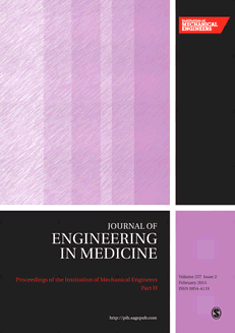
PROCEEDINGS OF THE INSTITUTION OF MECHANICAL ENGINEERS PART H-JOURNAL OF ENGINEERING IN MEDICINE
Transforming Medicine: Engineering the Future of HealthcareProceedings of the Institution of Mechanical Engineers Part H - Journal of Engineering in Medicine is a pivotal publication in the interdisciplinary realm of mechanical engineering and medical technology. Published by SAGE Publications Ltd, this esteemed journal delivers cutting-edge research and innovative solutions that bridge the gap between engineering principles and medical applications. With an impressive reputation, the journal is ranked in the Q2 category for Mechanical Engineering and Q3 for miscellaneous Medicine in 2023, reflecting its significant contribution to the field. Boasting an impact factor that positions it favorably in both mechanical engineering and medical research, it serves as a critical platform for researchers, professionals, and students eager to advance their knowledge and influence the future of engineering in healthcare. This journal encompasses diverse topics, driving forward the synergy between engineering and medicine while promoting discussions and discoveries that shape industry practices globally.

Computational Particle Mechanics
Innovating Through Particle-Based SimulationsComputational Particle Mechanics, published by SPRINGER INTERNATIONAL PUBLISHING AG, is a leading journal dedicated to advancing knowledge in the interdisciplinary fields of computational mechanics, civil engineering, and fluid dynamics. With an impressive impact factor reflecting its high-quality research publications, this journal maintains a strong presence in the academic community with a Q1 ranking in categories such as Civil and Structural Engineering, Computational Mechanics, and Numerical Analysis as per the latest 2023 evaluations. Researchers and professionals benefit from the journal's commitment to open-access options, promoting wider dissemination of groundbreaking studies. Operating under the Swiss publishing house since 2014, Computational Particle Mechanics aims to foster innovation through the exploration of particle-based methods and simulations, making significant contributions to methodologies within computational mathematics and modeling. As the journal continues to evolve until its converged years end in 2024, it stands as a vital resource for those looking to enhance their expertise in dynamic modeling and simulation techniques.
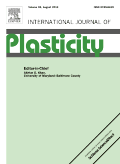
INTERNATIONAL JOURNAL OF PLASTICITY
Unveiling the Dynamics of Plastic MaterialsINTERNATIONAL JOURNAL OF PLASTICITY, published by Pergamon-Elsevier Science Ltd, stands as a pivotal forum in the field of materials science and engineering, exploring the nuances of plastic behavior in materials. With its ISSN 0749-6419 and E-ISSN 1879-2154, this esteemed journal has been a cornerstone of academic research since its inception in 1985, continuing to hold significant relevance as it converges towards 2024. Ranking in the Q1 quartile across multiple categories, including Materials Science (Miscellaneous), Mechanical Engineering, and Mechanics of Materials, it is recognized for its high impact, evidenced by its competitive Scopus rankings that place it in the 97th percentile among mechanical engineering journals. Although it does not offer open access, the journal remains committed to disseminating cutting-edge research findings that advance understanding in plasticity, providing researchers, professionals, and students with vital insights into contemporary issues and innovations in the field.

Journal of Theoretical and Applied Mechanics
Innovating Solutions in Theoretical and Applied MechanicsJournal of Theoretical and Applied Mechanics, published by the Polish Society of Theoretical and Applied Mechanics, stands as a leading platform for disseminating cutting-edge research in the realms of theoretical and applied mechanics. With its ISSN 1429-2955 and E-ISSN 1429-2955, this Open Access journal has been fostering academic dialogue since 2006, making knowledge readily accessible to researchers and practitioners alike. Based in Warsaw, Poland, the journal encompasses a wide breadth of topics within mechanics, appealing to a diverse readership including researchers, professionals, and students. The journal's current Scopus ranking places it within the 30th percentile of the field, emphasizing its relevance and contribution to the discipline. As it converges from 2007 to 2024, the Journal of Theoretical and Applied Mechanics is pivotal for those seeking to advance understanding and innovation in mechanical engineering and mathematics, making it an essential resource for anyone involved in these critical areas of study.

COMPUTATIONAL MECHANICS
Elevating Research Standards in Computational MechanicsCOMPUTATIONAL MECHANICS, published by SPRINGER, is a premier international journal that focuses on the intersection of applied mathematics, engineering, and computational methods. With a commendable Q1 ranking in multiple categories, including Applied Mathematics and Mechanical Engineering, this journal is pivotal for disseminating groundbreaking research and innovative methodologies that advance the field. The journal has steadily contributed to the academic community since its inception in 1986 and continues to lead discussions and practices in computational mechanics and related disciplines. With a robust impact reflected in its Scopus rankings—placing it within the top percentiles across various categories—COMPUTATIONAL MECHANICS serves as a crucial platform for researchers, professionals, and students seeking to explore and contribute to significant advancements in computational theory and mathematical applications. Although it does not currently operate under an open access model, the journal ensures wide accessibility through libraries and institutional subscriptions, fostering a rich exchange of knowledge in the global scientific community.

CONTINUUM MECHANICS AND THERMODYNAMICS
Driving Progress in Mechanics and Thermodynamic ApplicationsCONTINUUM MECHANICS AND THERMODYNAMICS is a prestigious academic journal published by Springer, focusing on the interdisciplinary fields of mechanics, materials science, and thermodynamics. With an ISSN of 0935-1175 and E-ISSN 1432-0959, this journal serves as an essential platform for researchers and practitioners to disseminate innovative findings and methodologies that advance theoretical and practical applications in these pivotal areas of science. Operating from Germany, this journal has gained significant recognition, achieving a Q2 quartile ranking in multiple categories, including Materials Science and Mechanics of Materials, as noted in the 2023 metrics. With Scopus rankings highlighting its competitive standing—ranked #65 in General Physics and Astronomy and #118 in Mechanics of Materials—CONTINUUM MECHANICS AND THERMODYNAMICS is committed to publishing high-quality, peer-reviewed research that fosters knowledge exchange and drives progress. While it currently does not offer Open Access, this journal remains a vital resource for those committed to exploring the complexities of continuum mechanics and thermodynamic processes.
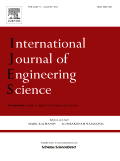
INTERNATIONAL JOURNAL OF ENGINEERING SCIENCE
Unveiling Breakthroughs in Mechanical Engineering and BeyondInternational Journal of Engineering Science, published by Pergamon-Elsevier Science Ltd in the United Kingdom, stands as a premier platform for pioneering research in the diverse fields of engineering and materials science. Since its inception in 1963, this journal has consistently demonstrated its commitment to advancing academic discourse, maintaining an impressive trajectory that positions it in the Q1 category across multiple engineering disciplines including Mechanical Engineering and Mechanics of Materials as of 2023. With notable Scopus rankings—placing it in the top 5% percentile for Mechanical Engineering and related fields—this journal attracts high-quality, impactful research designed for both industry practitioners and academic scholars. Although it does not currently offer Open Access options, its readership is enriched by comprehensive peer-reviewed articles, fostering a deeper understanding of complex engineering problems and innovative solutions. The International Journal of Engineering Science continues to be an invaluable resource for researchers, professionals, and students committed to pushing the boundaries of knowledge in engineering and materials science.
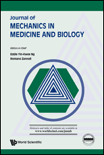
Journal of Mechanics in Medicine and Biology
Innovating at the Crossroads of Engineering and BiologyThe Journal of Mechanics in Medicine and Biology, published by World Scientific Publishing Co Pte Ltd, serves as a critical platform for interdisciplinary research at the intersection of engineering and biomedical sciences. With an ISSN of 0219-5194 and E-ISSN of 1793-6810, this esteemed journal has been dedicated to exploring the mechanical principles that govern biological systems since its inception in 2008. Based in Singapore, it addresses a diverse range of topics, from biomaterials to biomechanics, contributing valuable insights into the field’s evolving landscape. Although currently positioned in Q4 of Biomedical Engineering according to the 2023 category quartiles, it is poised for growth and increased visibility within the scientific community, fostering innovation and collaboration among researchers, professionals, and students alike. The journal emphasizes the importance of cutting-edge research and its practical implications, making it a vital resource for those striving to enhance the future of medical technologies and biological understanding.
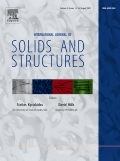
INTERNATIONAL JOURNAL OF SOLIDS AND STRUCTURES
Innovating the Future of Structural EngineeringINTERNATIONAL JOURNAL OF SOLIDS AND STRUCTURES, published by PERGAMON-ELSEVIER SCIENCE LTD, is a leading academic journal with a strong reputation in the fields of engineering and applied mathematics. Established in 1965 and converging its impact on research through 2024, this journal is highly regarded within Q1 quartile rankings across multiple disciplines, including Applied Mathematics, Condensed Matter Physics, and Mechanical Engineering. With its ISSN 0020-7683 and E-ISSN 1879-2146, the journal is systematically indexed and accessible to a global audience, although it does not currently offer open access options. Researchers, professionals, and students alike benefit from its high-impact research articles, as evidenced by its impressive Scopus rankings in various categories, including a 91st percentile in Applied Mathematics and 81st in Mechanical Engineering. The journal serves as a critical platform for the dissemination of groundbreaking findings in solid and structural mechanics, promoting innovation and collaboration within the scientific community.
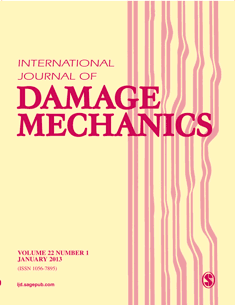
INTERNATIONAL JOURNAL OF DAMAGE MECHANICS
Driving Excellence in Damage Mechanics ResearchINTERNATIONAL JOURNAL OF DAMAGE MECHANICS, published by SAGE PUBLICATIONS LTD, stands as a pivotal peer-reviewed platform contributing to the fields of damage mechanics, computational mechanics, and materials science. With its ISSN 1056-7895 and E-ISSN 1530-7921, this esteemed journal has charted an impressive trajectory since its inception in 1992 and continues to influence the academic community through its high-quality research outputs. Recognized for its excellence, the journal has consistently ranked in the Q1 quartile across various categories including Computational Mechanics and Mechanical Engineering in 2023, reflecting its critical impact in these domains. It has attained an outstanding Scopus rank of #7/89 in Computational Mechanics, positioning it within the top tier of journals in the engineering discipline. The journal's commitment to advancing knowledge is further underscored by its broad scope that attracts innovative research, making it an essential resource for researchers, professionals, and students alike. Though it operates under a traditional subscription model, readers are encouraged to access its wealth of information, which is instrumental in promoting scholarly communication and driving forward the frontiers of damage mechanics.